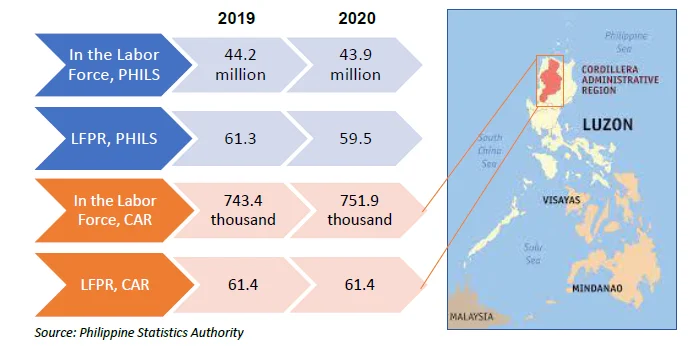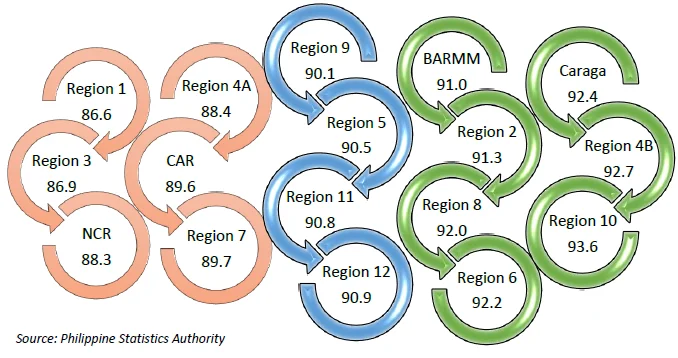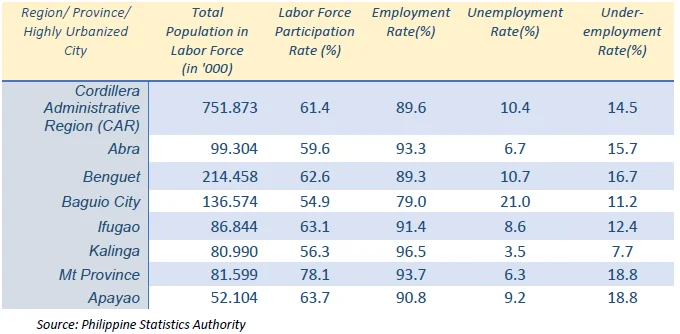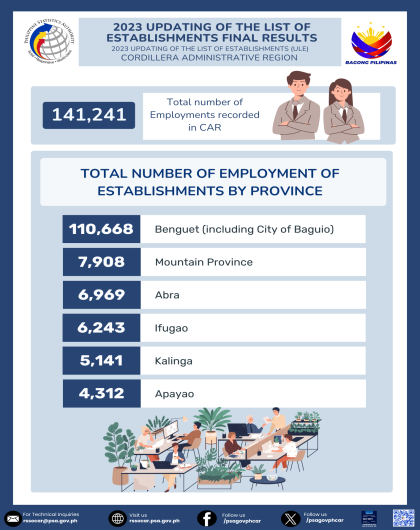Note: The annual estimates of labor and employment indicators is based on the methodology prescribed in the Philippines Statistics Authority (PSA) Board Resolution No. 04 Series of 2021: “Adopting the General Method for Annualized Estimates for the Labor Force Survey 2021 and Beyond.”



CAR labor participation rate remained at 61.4% despite the pandemic
- When the COVID-19 pandemic commenced in 2020, the total population in the labor force in the entire region was estimated at 752 thousand individuals. This was an increase of 1.2 percent from the 743 thousand economically active persons from the previous year.
- The labor force participation rate (LFPR) in CAR stayed at 61.4 percent despite the effects of the pandemic in 2020. This was higher than the national LFPR at 59.5 percent in that year. National LFPR declined from 2019 with 61.3 percent labor participation (Figure 1).
Figure 1. Population in the Labor Force and Labor Force Participation Rate,
Philippines and Cordillera Administrative Region: 2019 and 2020

- Along with the Cordillera region, the following also recorded LFPR above 60 percent in 2020: Northern Mindanao (66.3 percent), Caraga (63.5), SOCCSKSARGEN (62.9), Ilocos (62.6), CALABARZON (61.7) and Cagayan Valley (61.3). Other regions had lower participation rates, wherein the Bangsamoro region estimated a participation rate of 53.5 percent.
- In CAR, decreased annual labor market were estimated in the provinces of Abra (59.6 percent) and Kalinga (56.3 percent) and the lone highly urbanized Baguio City (54.9 percent). Labor participation in Benguet and Ifugao was the same in the face of the pandemic with 62.6 percent and 63.1 percent, respectively.
- Even with the restrictions imposed in 2020, Mountain Province had reported an increase in their labor market with 81.6 thousand persons from 75.3 thousand in the immediate pre-pandemic year. This was also evident with the improvement of its LFPR of 78.1 percent from 72.6 percent in 2019.
- Apayao also improved its LFPR as it increased to 63.7 percent in 2020 from 58.2 percent in 2019. This translated to an addition of nearly five thousand persons in the provincial labor market of 47.5 thousand prior to the pandemic year.
Employed persons in Cordillera declined by 6.1%
- The number of employed persons in the region dropped from about 717.3 thousand in 2019 to 673.4 thousand workers in the pandemic year. This was lesser by 6.1 percent than the annual rate in the pre-pandemic year.
- In terms of its ratio with the total economically active persons, employment went down to 89.6 percent in 2020 from its usually high rate of 96.5 percent in 2019. This figure was near the national employment rate of 89.7 percent.
- In general, the employment in all regions of the country decreased right in the first year of pandemic. However, five other regions along with CAR hit the employment rate below the 90 percent-level: Central Visayas (89.7), CALABARZON (88.4), National Capital Region (88.3), Central Luzon (86.9), and Ilocos Region (86.6) (Figure 2).
- The employment in the Cordillera provinces also declined in 2020. Despite this pattern, Kalinga (96.5), Mountain Province (93.7), Abra (93.3 percent), Ifugao (91.4) and Apayao (90.8) retained the employment rates above 90 percent.
- The provinces of Benguet and Baguio City were the most affected by the imposed restrictions due to COVID-19. The employment rate in Benguet dropped to 89.3 percent, from its annual rate of 96.8 the year before, while Baguio City’s employment plunged to its record low of 79.0 percent from 94.4 percent in 2019.
Figure 2. Employment Rates by Region, Philippines: 2020

Unemployed persons in the region increased by 52 thousand
- Consequently, the number of unemployed persons tripled from only 26.1 thousand persons in 2019 to about 78.4 thousand in the first year of the pandemic. Most of these were in the province of Benguet and Baguio City.
- The unemployment rate (UR) in the region reached 10.4 percent, which was at par with the national UR of 10.3 percent. This was way higher than the unemployment rate in 2019 at only 3.5 percent.
- Among other regions, Ilocos Region (13.4 percent), Central Luzon (13.1), National Capital Region (11.7), CALABARZON (11.6) and Central Visayas (10.3) surpassed the 10 percent-mark of UR. The rest of the regions were still above the 5 percent level of unemployment.
- Among provinces in CAR, only Kalinga province (3.5 percent) barely reached the 5 percent-level given that all areas in the region experienced increases in unemployment. Mountain Province (6.3), Abra (6.7), Ifugao (8.6), and Apayao (9.2) surpassed this level but still not a double-digit unemployment rate (Table 1).
- The major contributors to the regional unemployment, Benguet (10.7 percent) and Baguio City (21.0 percent), recorded an estimated 51.5 thousand unemployed persons who reported no economic activity in the past week reference during the initial pandemic year.
Employed persons wanting additional hours at 97.8 thousand
- Among the employed in CAR, there were 97.8 thousand persons who desired more hours of work or an additional job in 2020. This was an increase from 87.3 thousand underemployed persons from the pre-pandemic year.
Table 1. Labor and Employment Data by Provinces and Highly Urbanized City,
CAR: 2020

- Factored in the total employment, CAR underemployment rate (UER) increased by 2.3 percentage points from 12.2 percent in 2019 to 14.5 percent in 2020. This was still below the national UER of 16.2 percent.
- Six regions had notably high UER in 2020: Bicol Region (27.5 percent), MIMAROPA (23.9), Northern Mindanao (23.6), Caraga (23.0), SOCCSKSARGEN (22.2), and Eastern Visayas (20.1). All reported underemployment rates of 20 percent or higher during the initial pandemic year.
- Underemployment in Kalinga province was the least among provinces in the Cordilleras with 7.7 percent in 2020. This was even lower than the UER in the previous year. Ifugao also recorded a lower underemployment with 12.4 percent from UER of 17.3 percent in 2019 (Table 1).
- Like in Ifugao, the remaining provinces of Abra, Benguet, Mountain Province and Apayao, together with Baguio City, also reached double-digit underemployment rates. An increase in the employed persons wanting more working hours or additional job were seen in all these areas.


